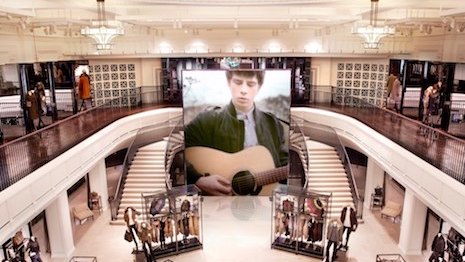- About
- Subscribe Now
- New York,
October 2, 2018

 Burberry's Regent Street flagship blends physical and digital. Image credit: Burberry
Burberry's Regent Street flagship blends physical and digital. Image credit: Burberry
While the majority of luxury purchases still take place offline, millennials buy 58 percent of their high-end goods via digital channels, making ecommerce and in-store technology key to reaching the next generations of luxury consumers.
According to Walpole’s “Luxury and Technology” report, produced in partnership with CBRE, many brands have made strides in technology, but others remain hesitant to embrace newer forms of retail across channels, for fear that doing so will dilute their image or authenticity. Leveraging innovation across channels with an eye towards consumer value can help brands drive growth in a challenging retail environment.
Walpole was reached for comment.
Reimagining retail
Euromonitor notes that luxury retailing in the United Kingdom grew 33 percent from 2012 to 2017.
In a Walpole and McKinsey study from 2016, 42 percent of brands surveyed said that ecommerce was a key growth driver from 2010 to 2015. The report also found that more than half of brands surveyed felt they had been impacted negatively by an underinvestment in ecommerce.
Walpole notes that while some brands have made the choice to stay off ecommerce to protect their exclusivity and image, forgoing online sales will alienate shoppers in the future. About one in five retail sales in the U.K. are expected to happen online by 2021, according to projections from CBRE.
Therefore, the report calls having a transactional Web site an “almost unavoidable requirement” at meeting consumer expectations.
A prime example of the rise of ecommerce is Fortnum & Mason, which updated its Web site in 2015 to be fully responsive. Since the revamp, the brand has seen its online sales grow 78 percent.
Fortnum & Mason has seen its sales grow online. Image credit: Fortnum & Mason
There remain risks with going online, such as the possibility of counterfeits and the negative impact of returns. The report notes that returns can be avoided by providing high-quality imagery and information about products, helping shoppers make more confident choices.
Meanwhile, rulings in Europe have made it possible for brands to more closely protect where their products are sold online, keeping their merchandise off marketplaces where the possibility of encountering counterfeits is high.
Luxury brands can also maintain a sense of exclusivity online by keeping their most special items limited to the bricks-and-mortar environment.
Even though ecommerce is of growing importance to luxury retail, the in-store experience remains a key part of the luxury buying process.
Consumers still want to be able to touch and feel merchandise, and stores offer an opportunity to communicate the intangible added value of luxury goods.
A key element of the in-store experience is the frontline associate, who makes personal connections with consumers and turns shopping into an event.
As with ecommerce, technology is playing a key role in customer service. For instance, Burberry’s Regent Street flagship store immerses consumers in its brand through screens that play content.
For a more personalized experience, sales associates leverage iPads to pull up a shopper’s purchase history, allowing them to consult and offer relevant suggestions.
Harrods similarly uses in-store technology to help guide consumers. The retailer rolled out beacons that interact with its mobile application, allowing shoppers to navigate to a particular product on the sales floor.
Harrods' mobile store guide. Image credit: Harrods
In addition to beacons, Harrods is working with Quividi to anonymously identify consumer responses to its digital advertising, allowing it to see who it is reaching with placements.
Online retailer Farfetch is furthering efforts to humanize the retail experience by closing the loop between digital and in-store selling with its Store of the Future launch last year. The concept will link together the online and offline worlds through data touchpoints that enhance and personalize the retail experience for consumers while presenting sales associates with chances to become in-store influencers (see story).
Omnichannel approach
Walpole’s report notes that retail efforts in the United Kingdom are not only aimed at local clientele. While Britain has long been a key tourism destination, the nation’s vote to leave the European Union and the resulting deflation of the pound have helped to make the United Kingdom an even more attractive spot for shopping tourism (see story).
Retail real estate in London has also seen shifts. Locations on avenues such as Bond Street and Sloane Street remain attractive for luxury brands, but newer areas of interest are also finding favor with high-end labels.
Dior Beauty in Covent Garden. Image credit: Covent Garden
Covent Garden has been undergoing a revitalization over the last decade, and in recent years has seen the opening of stores for Burberry Beauty, Mulberry and Dior Beauty. In 2017, 41 percent of Covent Garden’s 40 million visitors were international shoppers.
As ecommerce becomes a greater part of the luxury goods business, store formats may change.
In the changing luxury business, the retail expansion that drove 60 percent of the growth in previous years will be replaced by organic growth, which will now account for 70 percent of the market's development. With consumers slowing their purchases of hard luxury in favor of experiences, BCG advises a revamped bricks-and-mortar strategy that optimizes efficiency of square footage (see story).
However, while stores may be smaller, they will continue to be crucial, even as millennials and Gen Z consumers age into luxury.
According to a report from Astound Commerce, 59 percent of consumers consider a brand’s in-store experience before shopping with that retailer, while 78 percent agree that a positive interaction with a sales associate can convince them to buy. Finding ways to fuse the physical and the digital will be key for retailers going forward, as millennials are more likely than the average consumer to take advantage of cross-channel services (see story).
Share your thoughts. Click here